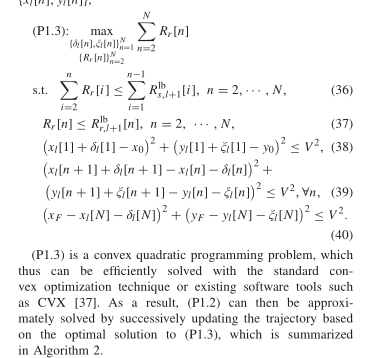clear all
clc
cvx_begin
expression s_p;%源节点的位置
s_p=[0 0 0];
expression d_p;%目的节点的位置
d_p=[2000 0 0];
% expression H;%无人机的飞行高度
% H=100;
expression N;%时隙数
N=100;
expression gamma_0;%参考距离处的信噪比
gamma_0=10^8;
expression u_p_0;%无人机的初始位置
u_p_0=[1000,500,100];
expression u_p_f;%无人机的最终位置
u_p_f=[1500,500,100];
expression u_p(N,3);%无人机在每个时隙中的坐标(初始轨迹)
expression v_max;%无人机的最大的飞行速度
v_max=50;
expression u_min;%无人机的最小飞行距离
u_min=500;
expression h_sr(N,1);%源节点到中继的自由空间路径损耗
expression h_rd(N,1);%中继到目的节点的自由空间路径损耗
expression d_sr(N,1);%源节点到中继的距离
expression d_rd(N,1);%中继到目的节点的距离
expression R_s(N,1);%源节点到中继的速率
expression R_r(N,1);%中继到目的节点的速率
expression p_s;%源节点的功率
p_s=0.01;
expression p_r;%中继功率
p_r=0.01;
%% 初始轨迹
for i=1:N
u_p(i,1)=1000+5*(i-1);%无人机的初始轨迹
u_p(i,2)=500;
u_p(i,3)=100;
end
% for i=1:N
% d_sr(i,1)= sqrt(sum((u_p(i,:)-s_p).^2)+H^2);%计算初始轨迹所对应的距离
% d_rd(i,1)=sqrt(sum((d_p-u_p(i,:)).^2)+H^2);%
% R_s(i,1)=log2(1+p_s*gamma_0/d_sr(i,1)) ;
% R_r(i,1)=log2(1+p_r*gamma_0/d_rd(i,1)) ;%初始轨迹所对应的速率
% end
%% 优化参数
expression gamma_s;%无人机功率比上噪声功率
gamma_s=1.99*10^11;
expression gamma_r;%中继功率比上噪声功率
gamma_r=1.99*10^11;
expression a_s(N,1) ;%
expression b_s(N,1) ;%
expression c_s(N,1) ;%因子
expression a_r(N,1) ;%
expression b_r(N,1) ;%
expression c_r(N,1) ;%因子
expression u_p_l(N,3);%无人机在每个时隙中的坐标
expression R_s_l1(N,1) ;%源节点到中继速率的下界
expression R_r_l1(N,1) ;%中继到目的节点的下界
%% CVX求解最优解
%cvx_begin
minimize(sum(R_r)-R_r(1,1))
subject to
variable delte(N);%x方向的运动增量
variable epsilon(N);%y方向的运动增量
u_p_l(:,1)=u_p(:,1)+delte(N);%
u_p_l(:,2)=u_p(:,2)+epsilon(N);%y轴运动坐标加运动增量
u_p_l(:,3)=u_p(:,3);%z轴不变
u_p_l(1,:)=u_p_0;%初始位置
u_p_l(N,:)=u_p_f;%最终位置
for i=1:N
d_sr(i,1)= norm(u_p_l(i,:)-s_p);%计算初始轨迹所对应的距离(源节点到中继)
d_rd(i,1)=norm(d_p-u_p_l(i,:));%计算初始轨迹所对应的距离(中继到目的节点)
d_sr(i,1)
R_s(i,1)=log2(1+p_s*gamma_0/d_sr(i,1)) ;
R_r(i,1)=log2(1+p_r*gamma_0/d_rd(i,1)) ;%初始轨迹所对应的速率
%
a_s(i,1)=gamma_s*(exp(1))/(d_sr(i,1)^2*(gamma_s+d_sr(i,1)^2));
b_s(i,1)=2*u_p_l(i,1)*a_s(i,1);
c_s(i,1)=2*u_p_l(i,2)*a_s(i,1);
%
a_r(i,1)=gamma_r*log2(exp(1))/(d_rd(i,1)^2*(gamma_r+d_rd(i,1)^2));
b_r(i,1)=-2*(d_p(1,1)-u_p_l(i,1))*a_r(i,1);
c_r(i,1)=2*u_p_l(i,2)*a_r(i,1);
R_s_l1(i,1)=R_s(i,1)-a_s(i,1)*(delte(i)^2+epsilon(i)^2)-b_s(i,1)*delte(i)-c_s(i,1)*epsilon(i);
R_r_l1(i,1)=R_r(i,1)-a_r(i,1)*(delte(i)^2+epsilon(i)^2)-b_r(i,1)*delte(i)-c_s(i,1)*epsilon(i);%速率的下界
end
expression Sum_R_r(N-1,1);%速率的和矩阵
expression Sum_R_s_l1(N-1,1);%速率下界的和矩阵
for i=2:N
for ii=2:i
Sum_R_r(i-1,1)=Sum_R_r(i-1,1)+R_r(ii,1);
end
end
for i=2:N
for ii=1:i-1
Sum_R_s_l1(i-1,1)=Sum_R_s_l1(i-1,1)+R_s_l1(ii,1);
end
end
% minimize(sum(R_r)-R_r(1,1))
% subject to
for i=1:N-1
Sum_R_r(i,1)<=Sum_R_s_l1(i,1);
end
for i=2:N
R_r(i,1)<=R_r_l1(i,1);
end
for i=2:N
norm(u_p_l(i,:)-u_p_l(i-1,:))<=expressionv_max^2;
end
cvx_end
I want to solve a simple convex problem that maximizes the rate of the devices. But, when I run the program it gives me this error,
Disciplined convex programming error:
Invalid operation: {1e+06} / {positive convex}
Error in / (line 74)
Looking forward to your reply, thank you!
